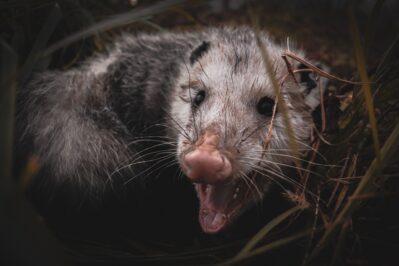Ready to learn about local ecology!
What's this?
River's Park Edge and its partners are pleased to offer all visitors a fun, educational challenge to locate ecological clues thoughout the park.
Learn more
Virginia opossum
Didelphis virginiana
With 50 teeth, the Virginia Opossum is the toothiest mammal in the United States and the only marsupial native to our country, which means they carry their underdeveloped babies in a pouch.
Scroll to learn more
Prev NextWhat else can I find?
River's Park Edge is home to many points of interest. But if you found this information interesting, keep seeking out more clues.
Seek for more ecology clues
Opposums are unique creatures.

Similar to monkeys, opposums have a prehensile tail, meaning they can use it to climb and hold leafy materials, and opposable thumbs for grasping. Unlike monkeys, opposums do not hang from their tails.
Opposums are notorious for their emergency defense mechanism: going limp and pretending to be dead when they think they’re in danger. “Playing dead” is a biological reaction that opposums can’t fully control. Although this defense may work for many wild animals, dogs may pick up fainted opossums and injure them.
These adaptable animals prefer forest habitats, but they can be found living in urban and suburban areas. As wanderers, opossums do not have well-defined territories and tend to stay in an area for only a few days.
Opposums’ strong sense of smell helps them find food sources. As omnivores, they enjoy a variety of plant and animal matter, including worms and insects, small mammals and dead animals, and garbage.
Opossums are nocturnal. When they are stressed, they may be seen foraging for food during the day, like when they are pregnant or during a cold winter. In the winter, opossums can wait out a cold spell, but hunger will force them out of their den. Their hairless, rounded ears and nearly bare tail are prone to frostbite, so they will choose a warmer time of day to search for food.
A female opposum, called a jill, can have up to two litters per year. Jills give birth to seven to 21 baby opossums, called joeys. The underdeveloped young must journey into their mother’s pouch, reducing the surviving litter size to seven to nine joeys. Joeys remain in their mother’s pouch for two months and will stay with her for another three months. During that time, you may see joeys clinging to their mother’s back. Mall opposums, called jakes, do not help care for the young.
Learn what to do if you find an injured, ill or dead opposum from Nebraska Wildlife Rehab.
